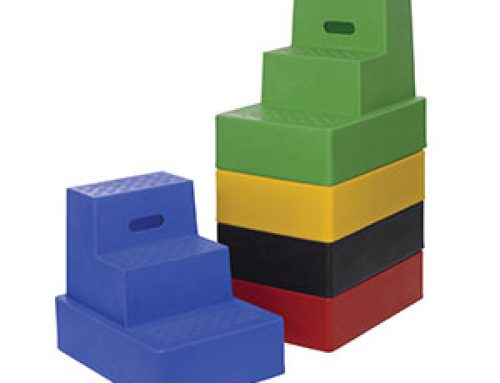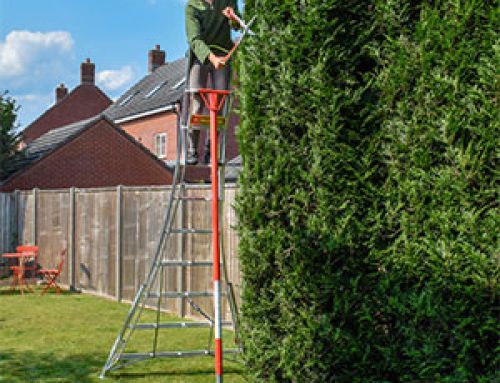One of the most common or everyday items that you can observe in any domestic or business setting is the step ladder. The multi-purpose functionality and the sheer convenience of using them, make these step ladders one of the most useful items at work or at home. Since most people intend to make a onetime purchase with a ladder, it is very important that the purchase be made with a great deal of forethought. Failing to attach sufficient importance in selecting the right kind of ladder may lead to a decision that you regret.
Step ladders are typical work platforms most people depend on when they want to perform domestic duties like changing a light bulb, cleaning a fan or a window. In industrial places, people use stepladders to remove goods from shelves or to restock them. One of the major reasons for the popularity of the stepladder is that it can be moved around easily, making it simple for most people to handle with minimum effort.
Step ladders are probably one of the more stable of the ladder types, making them feasible for home use and the non-professional. When you need to get to the top of the ladder in an emergency, you can easily do it without the help of another person. As the ladder is freestanding and stable, you don't have to prop it against any other surface. In a word, these ladders are self-sufficient!
Popular Makes of Stepladder
Some of the more popular ladders available in the market are:
Titan Heavy Duty Class 1 Builders Steps – The Class 1 Builders stepladder is more useful for industrial purposes, they are sturdy enough to perform challenging tasks such as building site work. The British certified standard for these stepladders is BS 2037 class 1. The biggest builder's stepladder can reach up to 3 metres and beyond while the short ones can give you a height of 0.75 metres. The excellent design promotes rigidity and stability. Titan Heavy Duty builder's steps have wide, non-slip treads making then both safe and comfortable in use. Each of the ladders in this class comes with 1-year warranty period. The maximum weight that can be handled by this type of class 1 ladder is 175kg and they are available in all sizes from 3 treads to 12 treads. You should be aware that builder's steps have no platform as such, and the top tread is the same size as the bottom tread. To ensure your safety, the top three treads should not be used to stand on as you would have no ladder in front of you to hold on to… so it is important to consider this when deciding which size stepladder to purchase.
Titan Medium Duty Class 1 Builders Steps – The medium duty ladders are ideal for both industrial and domestic use. They fulfil all the H&S regulations mandated by the European standard BS EN131 for quality and strength as well as BS2037 class 1. You can use them practically anywhere, place them indoors and use them to do the small household chores or place them in a warehouse where workers need to access the high shelves. The rigidity and strength of this ladder is further enhanced by the presence of tubular back legs. As the treads are double riveted, they are built to last. The Titan Ladder Company also answers the need for additional safety by incorporating top quality anti-slip treads and anti-slip rubber feet in all their step ladders.
Titan Heavy Duty Class 1 Platform Steps – Ideal for industrial and trade use. Each ladder has a strong locking facility that makes sure it is stable when used . The maximum load of these ladders is 175 kilograms, and they all come with robust rectangular box section back legs to promote stability and rigidity. These ladders, with their solid rubber feet, prevent slippage while ascending and descending, and their wide, comfortable treads offer both safety and comfort. They also carry the national British standard stamp – BS2037 class 1 for industrial use.
The large aluminium platform at the top of these ladders, offers a large area to support tools, buckets or paint pots while working.
Heavy Duty Aluminium Warehouse Steps – As the name suggests, these step ladders are used mainly in warehouses. They are identical in design to platform steps but are non-folding and are braced permanently open in the working position. They are fitted with rear rolling wheels as standard for easy manoeuvrability around the warehouse and safety handrails to both sides for added user confidence and security while ascending and descending. The rear wheels do not contact the ground until the front of the ladder is lifted, so there is no chance of the ladder moving when it is in the working position.
All the ladders mentioned above are made from heavy-duty aluminium; hence you can be assured of their durability and strength. Though aluminium is lightweight, you don't have any reason to doubt the stability of the ladders, as they are very strong. The portability factor of the aluminium ladder makes it special and unique. The Class 1 Kitemark label on the ladders vouches for the flawless performance given by them in any given situation. As the ladders are made from aluminium, you can place them outdoors, even when not in use, and not worry about rust and corrosion.
Aluminium stepladders are also popular these days, thanks to the versatility in both style and design. They are easy to handle and comfortable in use. As they are very strong, constant handling will not lead to deformity. The low maintenance feature of the aluminium ladder is an important factor too: It gives them the upper hand when compared to their wooden counterparts. The anti-corrosive feature is an added advantage when you lack storage space inside the house as you can easily store it inside your garage, or even leave it outdoors. True, aluminium step ladders are fire resistant, but never use a ladder that has been completely exposed to fire as they do lose the quality of integrated structure: Better to be safe than sorry.
Understanding the standards
The British standard BS 2037 and the European standard BS EN131 mentioned above are the main standards for all ladders and are categorised as follows…
British standards for aluminium Ladders
- BS 2037 Class 1 – Heavy industrial, Trade or domestic use (suitable for all) Max Load 175kg
- BS EN131 – Light Industrial, Trade or Domestic use – Max Load 150kg
- BS 2037 Class 3 – Domestic/ Home use only – Duty rating 95kg
Buying stepladders from a branded company will always ensure you buy the best and most suitable ladder for your needs. Some step ladders come fitted with handrails, and for those that come without the rails, you can usually have them fitted separately;Â most ladder suppliers are ready to fit them at a nominal rate.
Whilst you don't have to follow any particular rules while buying stepladders for domestic purposes, the same cannot be said for those looking to buy for industrial uses.
Tips for Buying Stepladders for Industrial Use
Nature of work – Identifying how the ladder will be used is a must. The possibility of any hazards should be taken into consideration whilst choosing a ladder, such as electrical hazards (use fibreglass) and a simple, thorough risk assessment of the workplace and task will give you an idea of the type of hazards that should be borne in mind. For example, 'do I need somewhere to place my paint can, brushes or tools?' if so then a platform step is far more suitable than a builders step.
Frequency and duration – you should carefully consider the frequency at which you intend to use your ladder. Industrial products are made to withstand vigorous, regular use, while lightweight, domestic products are designed and built for only very occasional use. If you identify a need to spend more than about 30 minutes at a time up your step ladder, you should consider an alternative such as a scaffold tower.
Selection of ladder – As there are so many varieties of stepladders, it is of paramount importance that you read the manufacturer's specifications in detail. You cannot necessarily use the same ladder for all the jobs for which you might need them. Similarly, you can ask your supplier if they can add any additional fittings to enhance the safety of the ladder such as extra handrails. Under no circumstances will the manufacturer change the entire structure of the ladder: however, he will enlighten you on the different kinds of uses each category of ladder is capable of.
Ladders should always be used with extreme care, so make sure any employees have had the appropriate training before using any of your equipment. There is no point in buying a decent step ladder and having an employee place it near a door that could be opened anytime, or placing it among a tangle of electric cables. Remember: A top quality, suitably selected stepladder + proper training = a safe, happy workplace!
Should your workforce require training, Midland Ladder Co. will be happy to quote for a 1 day course at your premises, which will ensure all your key employees are fully trained and issued with Ladder Association photo ID cards confirming their trained status. Give us a call on 0300 303 22 99.






Leave A Comment
You must be logged in to post a comment.